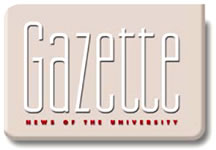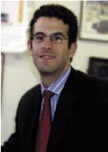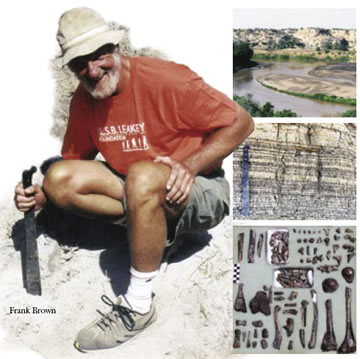
Vol. 15 No. 1 |
Summer 2005 |

NUMBER CRUNCHING 
20 The approximate number of illegal, unli- censed pieces of U of U merchandise discovered by the university’s Licensing Administrator Shane Hinckley between 2001 and November 2004.
20 The approximate number of pieces of illegal, unlicensed U of U merchandise Hinckley discovered during November 2004’s BYU/Utah football game
PRESIDENT MICHAEL K. YOUNG INAUGURATED
 |
| Photo by Lance W. Duffin |
Call it the most important party the U puts on.
Inaugurating the new president of a university is pomp and circumstance writ large, and the U did it in high style (and at low cost—this inauguration was completely paid for through donations) on April 15 in Kingsbury Hall, when Michael K. Young officially became the 14th president of the University of Utah. President Young’s remarks highlighted the University’s past, present, and future, including an outline of his vision for the U in the next 10 years. (For the full text of President Young’s speech, visit www.inauguration.utah.edu.) Celebratory events took place on campus all week prior to the inauguration: A variety of symposia were presented, including a discussion on new paradigms for environmental stewardship with noted poet W. S. Merwin and Salt Lake City Mayor Rocky Anderson, among others, and a special address by former Secretary of State James A. Baker III on U. S. Policy in the Middle East. Special cultural performances, museum exhibits, and a student ice cream social also honored the new president.

The 2005 Utah legislative session was one of the best in recent years for higher education, due primarily to the improved economy and the resulting increase in state tax revenues. Also credit the positive results in part to President Michael Young’s political savvy, and to the U’s 30 “Presidential Ambassadors,” a contingent of students who bent the ears of legislators—sometimes in the Capitol’s hallways—to advocate for the U. Alumni, faculty, staff, and retiree advocates were also actively engaged in promoting the U’s state funding priorities.
The Legislature provided substantial new funding for operations and capital facilities, including renovation of the J. Willard Marriott Library. The Legislature appropriated $48 million in one-time funding for the project, which includes earthquake retrofi tting on the 37-year-old main structure and a new, robotically controlled storage and retrieval system. Work is already under way and is scheduled for completion in 2008.
And good news for state-paid faculty and staff: The Legislature approved a 2.5 percent increase in funding for salaries. In addition, the U received $1,594,600 for health and dental insurance costs for a total compensation increase of 3.2 percent. These funds will be allocated to the University’s benefi ts pool and will offset a portion of the increases that employees would otherwise face in insurance premiums this July.
For the first time in several years the Legislature also appropriated new funds for the increased cost of fuel and power at the state’s universities, and for ongoing operations and maintenance. The Engineering Initiative, Nursing Initiative, Reading Clinic, Utah Museum of Natural History and Utah Museum of Fine Arts, New Century Scholarships, and High Technology Economic Development Initiative all received funding as well.
All told, the University’s ongoing state funding was increased by $12.5 million, or six percent. The U received an additional $6.1 million in one-time funds for operations and equipment.
FIGHTING LINGUISTIC EXTINCTION
 There
will be no rest for Lyle Campbell or his colleagues in the Department
of Linguistics. They may have just cut the ribbon on the University’s
new Center for American Indian Languages (CAIL), but time is of the
essence.
There
will be no rest for Lyle Campbell or his colleagues in the Department
of Linguistics. They may have just cut the ribbon on the University’s
new Center for American Indian Languages (CAIL), but time is of the
essence.
“The crisis of languages becoming extinct is horrendous,” explains Campbell, the center’s director. “It’s a big distress to all linguists.”
That crisis is illuminated by a key statistic: Only 20 of the 175 Native American languages still spoken in North America are being learned by the current generation of children. That leaves 155 languages—along with the knowledge, customs, and values embedded within them—fated to die within a single generation.
That’s where CAIL comes in. The center is primarily charged with assisting communities in revitalizing their endangered languages and cultures. In that role, linguists at CAIL are not only engaged in the research and documentation of those languages, but they are also involved in hands-on, grassroots efforts to breathe new life into indigenous communities.
Currently, CAIL is involved in two extensive research projects. The first, funded by the National Science Foundation, seeks to preserve and revitalize the endangered dialect of the Shoshoni. The second project, funded by the University of London’s Rausing Charitable Fund, documents three threatened languages in northern Argentina and southern Brazil.
Thanks to a new partnership with the Smithsonian Institute’s
National Museum of Natural History, CAIL now has even more resources with
which to tackle its daunting mission. The two institutions will sponsor
an annual conference on endangered languages, and have established a joint
publication series to be printed by the University of Utah Press.
TUITION INCREASE
The Board of Regents and the Legislature approved a 7.9 percent tuition increase for undergrads, which translates into about $265. Statewide, tuition increases averaged 8.3 percent for undergrads.
Three Questions
LIFELINE FOR THE INNOCENT
 While
working at Brooklyn Law School’s Second Look Program and litigating
post-conviction innocence claims by New York prisoners for three years,
law professor Daniel Medwed didn’t get much sleep—and still
doesn’t. “Sometimes, in the wee hours, I’ll recall a
letter I received from an inmate and think, ‘Maybe I should’ve
pursued that,’ ” he says. Medwed joined the U faculty fall
2004 and teaches a seminar on Wrongful Convictions in addition to courses
on Criminal Law, Evidence and Appellate Practice. He’s also on the
board of directors of the Rocky Mountain Innocence Center, and his research
interests revolve around the causes of wrongful convictions and the post-conviction
remedies available to free innocent prisoners.
While
working at Brooklyn Law School’s Second Look Program and litigating
post-conviction innocence claims by New York prisoners for three years,
law professor Daniel Medwed didn’t get much sleep—and still
doesn’t. “Sometimes, in the wee hours, I’ll recall a
letter I received from an inmate and think, ‘Maybe I should’ve
pursued that,’ ” he says. Medwed joined the U faculty fall
2004 and teaches a seminar on Wrongful Convictions in addition to courses
on Criminal Law, Evidence and Appellate Practice. He’s also on the
board of directors of the Rocky Mountain Innocence Center, and his research
interests revolve around the causes of wrongful convictions and the post-conviction
remedies available to free innocent prisoners.
Q: WHAT ARE SOME OF THE FACTORS THAT SOMETIMES LEAD
TO WRONGFUL CONVICTIONS?
A: Eyewitness misidentification is the biggest factor,
which is sometimes caused by a failure of memory or perception, or occasionally
based on unconscious biases. In particular, people often have difficulty
identifying members of different races, a phenomenon known as cross-racial
misidentification. Then there are also convictions based on false confessions—especially
with juveniles—or information from unreliable jailhouse informants
as well as an array of other factors.
Q: ABOUT HOW MANY INDIVIDUALS ARE WRONGFULLY CONVICTED
EACH YEAR?
A: It’s impossible to pinpoint a specific figure,
but the overall sum is not insignifi cant. But even if there were only
a handful of innocent defendants convicted each year, this is a major
cause for concern. If there were, say, a dozen airplane crashes a year,
people would be up in arms—and each wrongful conviction represents
a crash of the criminal justice system.
Q: WHAT IMPACT DOES CORRECTING WRONGFUL
CONVICTIONS HAVE ON THE SYSTEM?
A: The innocence movement is evolving into a force
to be reck-
oned with; the mere existence of organizations like the Rocky Mountain
Innocence Center provides a safeguard against injus-
tice. That is, prosecutors know that down the line there might be a law
student at the University of Utah checking up on the case, and this provides
an incentive to do things by the book.
OVERHEARD
“Universities are a distillation of our culture. They draw together our knowledge and inform subsequent generations about what we know—and more importantly, what we don’t know.”
—College of Mines and Earth Sciences Dean Frank Brown, speaking to the University’s Communications Council.
“We are becoming divided between the have-nothings and the have-way-too-muches….The working poor are now our biggest philanthropists.”
—Barbara Ehrenreich, author of Nickel & Dimed: On (Not) Getting By in America, in reference to the Bush administration’s tax cut policies, in a keynote address March 3 in the Union Ballroom.
“I felt like I was going into the state liquor store to buy a drink.”
—Provo Republican Congressman and BYU alum Jeff Alexander, explaining to State House leaders during a resolution to honor the Utes what it felt like to don a University of Utah cap.
SETTING BACK HUMANKIND’S CLOCK
 When
the bones of two early humans were found in 1967 near Kibish, Ethiopia,
they were thought to be 130,000 years old. A few years ago, researchers
found 154,000- to 160,000-year-old human bones at Herto, Ethiopia. Now,
a new study of the 1967 fossil site indicates the earliest known members
of our species, Homo sapiens, roamed Africa about 195,000 years
ago.
When
the bones of two early humans were found in 1967 near Kibish, Ethiopia,
they were thought to be 130,000 years old. A few years ago, researchers
found 154,000- to 160,000-year-old human bones at Herto, Ethiopia. Now,
a new study of the 1967 fossil site indicates the earliest known members
of our species, Homo sapiens, roamed Africa about 195,000 years
ago.
“It pushes back the beginning of anatomically modern humans,” says geologist Frank Brown, a co-author of the study and dean of the University of Utah’s College of Mines and Earth Sciences.
Pushing the emergence of Homo sapiens from about 160,000 years ago back
to about 195,000 years ago is significant because it suggests that Homo
sapiens existed for some 150,000 years before developing cultural
items such as flutes, needles, or tools. The journal Nature published
the study in its Feb. 17 issue. Brown conducted the research with geologist
and geochronologist Ian McDougall of Australian National University in
Canberra, and anthropologist John Fleagle of New York state’s Stony
Brook University.
VENTURE FUND GRABS HEADLINES
The U of U student-run University venture Fund found itself in the spotlight this spring in both USA Today (March 15) and Newsweek (March 21).
The U’s fund—which launched in January with a self-sustaining $5 million in seed money—is the only student venture fund to raise money publicly and one of only a few to invest in start-ups instead of publicly traded stocks.
Based at the David Eccles School of business, the fund was first endowed in 2002, with a $500,000 gift from Utah entrepreneurs James LeVoy Sorenson ex’48 and his son James Lee Sorenson BS’75. Silicon Valley financier Tim Draper (whose firm Draper Fisher Jurvetson’s investments include Hotmail) poured in $1 million, and other investors including UBS Bank USA and Morgan Stanley added more.
The fund’s first investment was $100,000 in a Silicon Valley medical device start-up called BaroSense. Any investment profit will go to altruistic efforts such as scholarships for low-income students.
U President Michael Young says he is pleased by the “wonderful stories” recently published about the fund, and celebrates the young entrepreneurs running the UVF as “a group of students who are not waiting to make their mark.”
The University of Utah racked up rankings in 21 separate categories in U.S. News & World Report’s 2006 list of top college and university graduate programs, several in the top 50 of their fields. The next most frequently mentioned school appears in five ranking categories.
 The
magazine ranks the top 100-plus schools and their individual programs
on the basis of up to 15 indicators of academic excellence, including
peer assessment, retention, faculty resources, entering student grades
and test scores, and graduation rate. The 2006 rankings are based on surveys
of some 1,300 programs and nearly 9,600 academics and professionals conducted
in fall 2004.
The
magazine ranks the top 100-plus schools and their individual programs
on the basis of up to 15 indicators of academic excellence, including
peer assessment, retention, faculty resources, entering student grades
and test scores, and graduation rate. The 2006 rankings are based on surveys
of some 1,300 programs and nearly 9,600 academics and professionals conducted
in fall 2004.
The U’s Health Sciences Center is a consistently strong performer in the rankings, and its College of Pharmacy ranks the highest of any U program this year at 14th in the nation, tying with the University of Southern California and the University of Washington. The family medicine, women’s health, and pediatrics programs were ranked 17th, 19th, and 20th, respectively. The School of Medicine also resumes its standing among the nation’s best in teaching primary care, ranking 44th out of 50.
The S. J. Quinney College of Law is at No. 49, a three-way tie with the University of Connecticut and Case Western Reserve University in Ohio. The U law school has made the top tier of all schools every year since the rankings began.
The David Eccles School of Business continues to rise among the top business schools, moving up eight spots from No. 64 to 56th in just one year, the biggest jump in rankings for any U school or program.
The Graduate School at the College of Engineering ranks 57th, with seven other rankings in a variety of specialties. Two of those specialties are newly ranked after not making the survey last year. Chemical Engineering claims the 61st spot, while Civil Engineering is 78th.
The College of Education's Graduate School is ranked No. 70, and the U ranks 111th overall in the top tier of 129 national universities.
For a complete listing of the U.S. News & World Report rankings of America’s Best Colleges, visit www.usnews.com.
IN MEMORIAM
Carl Inoway, 73, former dean of the U’s Graduate School of Architecture, died on February 3 in Cheyenne, Wyo. Prior to serving as dean of the school from 1986 to 1992, Inoway was a key figure in setting up architectural and design programs to benefit low- or fixed-income communities in Utah.
Barry Cushing, 59, accounting professor, died on March 2. Before cancer claimed him, Cushing cultivated a distinguished career at the U, beginning in the late ’70s. He is credited with transforming the U’s accounting department into One of the region’s premier programs.
Edward D. Maryon BFA’52, MFA’56, 74, died March 9 of complications related to Parkinson’s disease. Maryon became chair of the art department in 1962 and served as dean of the College of Fine Arts from 1964-1981. During his tenure, the University built a New art and architecture building, expanded the Museum of Fine Arts, and organized the ballet and modern dance departments.